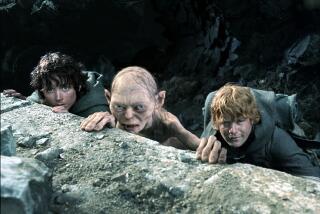Translating Tolkien for the Screen
- Share via
MADISON, Wis. — David Salo is an expert in languages that exist only in the imaginary world of hobbits and elves.
He has immersed himself in Quenya and Sindarin, languages created by author J.R.R. Tolkien for the inhabitants of Middle-earth in his “The Lord of the Rings” trilogy.
So when filmmakers adapting the fantasy epic wanted to translate parts of their script from English into the two Elvish languages, they turned to Salo, a graduate student in linguistics at the University of Wisconsin in Madison.
“I know it a lot better than most of the foreign languages I’ve studied,” the 32-year-old said.
Salo, who is studying Tocharian, an Indo-European language spoken in medieval China, said his interest in Tolkien’s languages started at age 6 or 7, when he read “The Lord of the Rings.”
The story follows hobbit Frodo Baggins on a quest, under the guidance of the wizard Gandalf, to destroy the all-powerful ring coveted by the dark lord Sauron.
“All these neat names and words and you want to know, ‘What do they mean?’” Salo said.
In the seven years between his undergraduate studies at Macalester College in St. Paul, Minn., where he studied Latin and Greek, and graduate school in Madison, Salo learned everything he could about Tolkien’s Elvish languages.
When he heard about plans to film “The Lord of the Rings,” he wrote director Peter Jackson and the film’s producers. His letter made two points: It was important to get Tolkien’s Elvish languages right, and Salo could help. A few months later, the producers called.
“I was shocked,” he said.
Before the film began shooting in New Zealand, Salo worked with set and costume designers, writing short verses that could be inscribed on swords and other props.
Tolkien created many languages, including Quenya and Sindarin, which Salo said are related the way English and German are.
Quenya resembles ancient Greek, while Sindarin is modeled on Welsh, Salo said, but Tolkien took borrowed elements of Latin, Finnish and Hebrew.
Some sample words: In Sindarin, the word for hobbit is periain, ang is iron, duath means darkness; hir means lord. In Quenya, parma means book, anga is iron, heru is lord, lumbule is darkness.
Translating dialogue took educated guesses on Salo’s part, since Tolkien never published a guide.
“He gives little hints here and there. So you look at that, you look at the patterns, and you extrapolate,” Salo said.
Once hired, Salo sent a tape of himself speaking the Elvish languages to Andrew Jack and Roisin Carty, the film’s dialect and language coaches, so they could teach the actors, including Cate Blanchett, Ian McKellen, Liv Tyler and Elijah Wood.
The filmmakers relied on Salo on the 15-month shoot, which included making Parts 2 and 3, due in theaters in 2002 and 2003.
“They would suddenly call me up at midnight ... and say, ‘We need you to write us a line of dialogue for the shooting tomorrow,’” Salo said.
He said it wouldn’t take him long to comply. “When you’ve been working with this for a while, it becomes like a second language.”
More to Read
Only good movies
Get the Indie Focus newsletter, Mark Olsen's weekly guide to the world of cinema.
You may occasionally receive promotional content from the Los Angeles Times.










